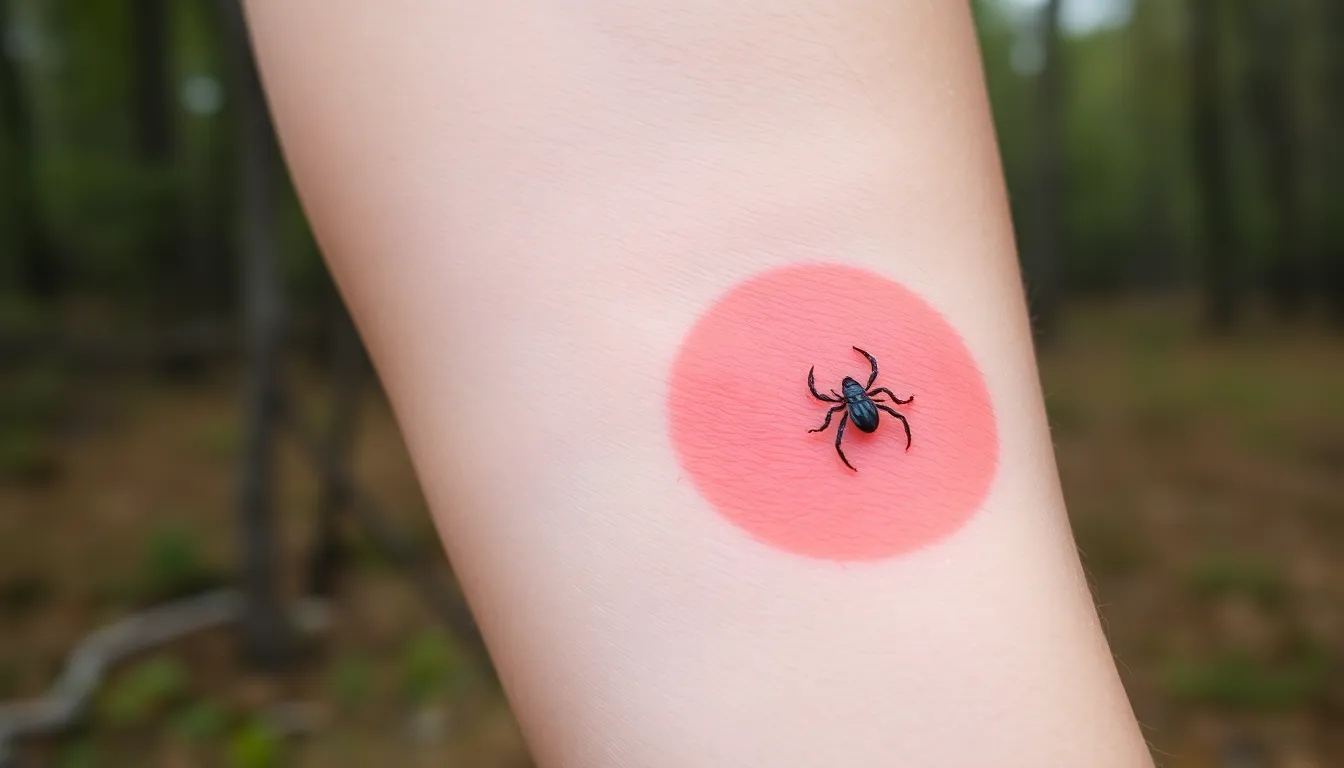Table of Contents
ToggleWhen it comes to outdoor adventures with man’s best friend, the last thing anyone expects is a surprise visit from a tiny, blood-sucking hitchhiker. Dog ticks might be small, but they pack a punch that could leave humans feeling less than fabulous. Whether you’re strolling through the park or hiking up a mountain, these little critters can latch on when you least expect it, turning a fun day into a not-so-fun experience.
Overview of Dog Tick Bites
Dog tick bites can lead to various health concerns for humans. Recognizing the significance of these bites fosters better prevention and response strategies.
Importance of Understanding Tick Bites
Understanding tick bites holds substantial importance due to the potential for disease transmission. Tick bites can cause serious illnesses, including Lyme disease and Rocky Mountain spotted fever. Awareness of symptoms facilitates early detection and treatment, reducing the risk of complications. Proper knowledge aids in preventive measures, such as using repellents and conducting regular tick checks after outdoor activities.
Types of Ticks and Their Habitats
Several tick species pose a threat to humans, each inhabiting specific environments. The black-legged tick commonly thrives in wooded or grassy areas, while the American dog tick often prefers open fields and can be found in urban settings. The lone star tick resides primarily in the southeastern and eastern regions of the United States. Each tick species has varying active periods, impacting their likelihood of biting humans during outdoor excursions. Understanding these habitats contributes to effective preventative strategies when spending time outdoors with pets.
Symptoms of Dog Tick Bites on Humans

Recognizing the symptoms of dog tick bites on humans is essential for prompt treatment. Different signs can indicate potential health issues caused by these bites.
Common Signs to Watch For
Look for redness and swelling at the bite site. Such inflammation usually appears within a few hours after the bite. Itching may also occur, making the area uncomfortable. Some individuals experience flu-like symptoms, including fatigue and fever, within a week of being bitten. In cases where Lyme disease develops, a distinctive circular rash sometimes forms, resembling a bullseye. The rash typically expands over several days. Occasionally, joint pain and muscle aches follow these symptoms. Awareness of these common signs aids in timely medical intervention.
Severe Reactions and Allergies
Certain individuals might experience severe allergic reactions after a dog tick bite. Symptoms like difficulty breathing and rapid heart rate indicate a potential anaphylactic reaction. Swelling in the face, lips, or throat can also develop, requiring immediate medical attention. Some may experience severe headaches or intense fatigue, signaling a more significant health concern. In rare instances, paralysis can occur due to certain tick-borne illnesses. These severe reactions emphasize the importance of monitoring symptoms closely and seeking assistance when necessary.
Health Risks Associated with Dog Tick Bites
Dog ticks pose significant health risks, particularly through their potential to transmit various diseases to humans.
Diseases Transmitted by Dog Ticks
Lyme disease ranks as one of the most notable illnesses linked to dog tick bites, caused by the bacterium Borrelia burgdorferi. Rocky Mountain spotted fever, another serious condition, results from Rickettsia rickettsii. Anaplasmosis and ehrlichiosis are additional diseases that ticks can transmit, leading to symptoms like fever, headaches, and muscle aches. Immediate medical attention is essential for anyone exhibiting these signs following a tick bite.
Long-Term Effects of Tick Bites
Long-term effects of tick bites can be profound and sometimes debilitating. Chronic Lyme disease, characterized by persistent joint pain, fatigue, and neurological issues, affects some individuals long after treatment. Tick-borne encephalitis, though less common, can lead to severe neurological complications. Timely diagnosis and appropriate treatment mitigate these risks, underscoring the importance of awareness regarding dog tick bites and their potential health consequences.
Prevention Strategies
Preventing dog tick bites requires a combination of protective measures for both humans and pets and effective home and yard maintenance.
Protecting Yourself and Your Pets
Wear long sleeves, pants, and closed-toe shoes when spending time outdoors. Utilize EPA-approved tick repellents on exposed skin to reduce the risk of bites. Keeping pets on a leash during walks minimizes their exposure to tick-infested areas. Regularly check pets for ticks after outdoor activity, focusing on areas such as ears, collar lines, and between toes. Consider tick prevention products for pets, like topical treatments or collars, which effectively reduce tick infestations. Being vigilant about these strategies enhances safety and promotes a healthy outdoor experience.
Home and Yard Maintenance Tips
Maintain a clean yard by regularly mowing the grass and trimming shrubs. Removing leaf litter and tall grasses helps create an environment less favorable for ticks. Installing gravel or wood chips along pathways defines areas where people walk, discouraging tick presence. Utilize natural tick repellents, such as cedar mulch, to deter ticks in landscaping. Regularly inspect outdoor furniture and play equipment for ticks. Taking these steps aids in minimizing the risk of ticks entering the home and decreases the likelihood of bites.
Treatment Options for Tick Bites
Timely treatment of tick bites is essential for reducing health risks. Immediate actions can alleviate symptoms and prevent complications.
First Aid for Tick Bites
First, remove the tick as soon as possible. Grasp the tick with fine-tipped tweezers close to the skin and pull upwards with steady pressure. After tick removal, clean the bite area with soap and water or an antiseptic wipe. Watching for symptoms like redness, swelling, and rash is necessary. Keep track of the bite’s location and monitor for any changes. Applying a cold pack can reduce swelling and discomfort. Over-the-counter pain relievers, like ibuprofen, can help ease any associated pain.
When to Seek Medical Attention
Seek medical attention if flu-like symptoms arise within a week after a tick bite. Notably, symptoms like fever, chills, and fatigue indicate possible illness. Immediate care is crucial if a circular rash develops, which may signal Lyme disease. Severe allergic reactions including difficulty breathing, swelling of the face, or rapid heartbeat require urgent medical intervention. Persistent symptoms such as joint pain or extreme fatigue call for an evaluation as well. Timely diagnosis and treatment significantly improve health outcomes in tick-related illnesses.
Dog tick bites can pose serious health risks that shouldn’t be underestimated. Awareness of symptoms and prompt action can make a significant difference in health outcomes. By taking preventive measures and maintaining vigilance during outdoor activities, individuals can enjoy their time with pets while minimizing the risk of tick bites. Regular checks and proper treatment can help ensure that any potential complications are addressed swiftly. Staying informed about ticks and their associated dangers is essential for safeguarding both personal health and that of beloved pets.







